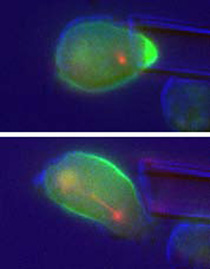- Kuhn J, Banerjee P, Haye A, Robinson DN, Iglesias PA and Devreotes PN. 2024. Complementary Cytoskeletal Feedback Loops Control Signal Transduction Excitability and Cell Polarity. bioRxiv [Preprint]. 2024 Feb 13:2024.02.13.580131. doi: 10.1101/2024.02.13.580131. PMC10888828.
- Balaban AE, Nguyen LTS, Parajón E, and Robinson DN*. Non-muscle myosin IIB is a driver of cellular reprogramming. Biol. Cell, 2023; In press. DOI: 10.1091/mbc.E21-08-0386.
- Plaza- Rodriguez a., Nguyen LTS, Robinson DN, Iglesias, PA. Particle-based model of mechanosensory contractility kit assembly. Biophys. J. 2022; 121: 1-15. DOI: https://doi.org/10.1016/j.bpj.2022.10.031
- Nguyen LTS and Robinson DN*. The lectin Discoidin I acts in the cytoplasm to help assemble the contractile machinery. Cell Biol. 2022; 221(11):e202202063. DOI: https://doi.org/10.1083/jcb.202202063
- Nguyen LTS, Jacob MAC, Parajón E, and Robinson DN*. Cancer as a biophysical disease: targeting the mechanical-adaptability program. J. 2022; 121(19): 3573-3585. DOI: https://doi.org/10.1016/j.bpj.2022.04.039.
- Angstadt S, Zhu Q, Jaffee EM, Robinson DN*, and Anders RA*. Pancreatic ductal adenocarcinoma cortical mechanics and clinical implications. Frontiers in Oncology, 2022; 12: 1-15.
- Srivastava V, Balaban AE. Robinson DN.* In Joseph Jez (ed) The Encyclopedia of Biological Chemistry 3rd Edition, 2021; Oxford: Elsevier. Vol. 5, pp. 42-48.
- DiNapoli, KT, Robinson DN, Iglesias PA. A mesoscale mechanical model of cellular interactions. J. 2021; 120: 4905-4917. DOI: https://doi.org/10.1016/j.bpj.2021.10.021
- Kliment CR, Nguyen JMK, Kaltreider MJ, Lu YW, Claypool SM, Radder JE, Sciurba FC, Zhang Y, Gregory AD, Iglesias PA, Sidhaye VK, Robinson DN*. Adenine Nucleotide Translocase regulates airway epithelial metabolism, surface hydration, and ciliary function. J. Cell Sci. 2021; 134(4): jcs257162.
- Nguyen J, Liu Y, Nguyen L, Sidhaye VK, Robinson DN*. Discovery and quantitative dissection of cytokinesis using Dictyostelium discoideum. Kimmel A. ed. Methods Mol. Biol. 2021; In press.
- Parajón E, Surcel A, Robinson DN*. The Mechanobiome: A Goldmine for Cancer Therapeutics. Am. J. Physiol.-Cell Physiol. 2020; In press. DOI: 10.1152/ajpcell.00409.2020
- Nguyen JMK, Robinson DN*, Sidhaye VK*. Why New Biology Must Be Uncovered to Advance Therapeutic Strategies for Chronic Obstructive Pulmonary Disease. Am. J. Phys. Lung Cell Mol. Physiol. 2020; In press. DOI: 10.1152/ajplung.00367.2020
- DiNapoli K, Robinson DN, Iglesias PA. Tools for computational analysis of moving boundary problems in cellular mechanobiology. Wiley Interdiscip Rev Syst Biol Med. 2020 Dec 10; e1514. doi: 10.1002/wsbm.1514.
- Woolums BM, McCray BA, Sung H, Tabuchi M, Sullivan JM, Ruppell K, Yang Y, Mamah C, Aisenberg WH, Saavedra-Rivera PC, Larin BS, Lau A, Robinson DN. TRPV4 disrupts mitochondrial transport and causes axonal degeneration via CaMKII-dependent elevation of intracellular Ca2+. Nat. Comm. 2020; 11(1):2679. doi: 10.1038/s41467-020-16411-5.
- Nguyen L, Robinson DN. The Unusual Suspects in Cytokinesis: Fitting the Pieces Together. Front. Cell Dev. Bio. 2020; 8:441. doi: 10.3389/fcell.2020.00441.
- Bryan DS, Stack M, Krystofiak K, Cichoń U, Thomas DG, Surcel A, Schiffhauer ES, Khodarev NN, Xue L, Poli EC, Pearson AT, Posner MC, Robinson DN, Rock RS, Weichselbaum RR. 4-hydroxyacetophenone modulates the actomyosin cytoskeleton to reduce metastasis. Proc. Natl. Acad. Sci. USA. 117 (36)22423-22429. doi.org/10.1073/pnas.2014639117. /PDF
- Kliment CR, Nguyen JMK, Kaltreider MJ, Lu YW, Claypool SM, Bailey KL, Radder JE, Sciurba FC, Zhang Y, Gregory AD, Iglesias PA, Sidhaye VK, Robinson DN*. Adenine Nucleotide Translocase regulates airway epithelial homeostasis, mitochondrial metabolism and ciliary function. bioRxiv. May 19 2020. DOI: 10.1101/2020.05.18.101378
Srivastava V, Balaban AE. Robinson DN.* Cytokinesis. In Joseph Jez (ed) The Encyclopedia of Biological Chemistry 3rd Edition, 2020; Academic Press, Waltham, MA., In press.
Crews DC, Wilson KL, Sohn J, Kabacoff CM, Poynton SL, Murphy LR, Bolz J, Wolfe A, White PT, Will C, Collins C, Gauda E, Robinson DN*. Helping scholars overcome socioeconomic barriers to medical and biomedical careers: Creating a pipeline initiative. Teach. Learn. Med. 2020; 1-12. DOI: 10.1080/10401334.2020.1729161.
Kothari P, Johnson C, Sandone C, Iglesias PA, Robinson DN. How the mechanobiome drives cell behavior, viewed through the lens of control theory. J. Cell Sci. 2019; 132:1-10. jcs234476.
Surcel A, Schiffhauer ES, Thomas DG, Zhu Q, DiNapoli K, Herbig M, Otto O, West-Foyle H, Jacobi A, Kräter M, Plak K, Guck J, Jaffee EM, Iglesias PA, Anders RA, Robinson DN. Targeting mechanoresponsive proteins in pancreatic cancer: 4-hydroxyacetophenone blocks dissemination and invasion by activating MYH14. Cancer Res. 2019; 79: 4665-4678.
Surcel A, Robinson DN.* Meddling with myosin’s mechanobiology in cancer. Proc. Natl. Acad. Sci. U.S.A. 2019; 116(31): 15322-15323.
Schiffhauer ES, Ren Y, Iglesias V, Kothari P, Iglesias PA, Robinson DN*. Myosin IIB assembly-state determines myosin IIB mechanosensitive dynamics. J. Cell Biol. 2019; 218(3): 895-908. (Includes 4 pages of Supplemental Figures)
Kothari P, Srivastava V, Aggarwal V, Tchernyshyov I, Van Eyk J, Ha T, and Robinson DN*. Contractility kits promote assembly of the mechanoresponsive cytoskeletal network. J. Cell Sci. 2019; 132(2): 1-12. (Cover article; includes 11 pages of Supplemental Figures and Tables; first author was featured in a “First Person – Priyanka Kothari” interview, J. Cell Sci 2019 132: jcs229195)
Schiffhauer ES, Ren Y, Iglesias V, Kothari P, Iglesias PA, Robinson DN. 2019. Myosin IIB assembly-state determines myosin IIB mechanosensitive dynamics. J. Cell Biol. In press.
Liu Y and Robinson D*. Recent advances in cytokinesis: Understanding the molecular underpinnings. F1000Research 2018; 7(F1000 Faculty Rev): 1849.
Duan R, Kim JH, Shilagardi K, Schiffhauer E, Lee, D, Son S, Li S, Thomas C, Luo T, Fletcher DA, Robinson DN, Chen EH. Spectrin is mechanoresponsive protein shaping the architecture of the fusogenic synapse during cell-cell fusion. Nat. Cell Biol. 20, 688-698.
West-Foyle H, Kothari P, Osborne J, Robinson DN. 14-3-3 proteins tune non-muscle myosin-II assembly. J. Biol. Chem. 2018; In press.
Evans JP, Robinson DN. Micropipette aspiration of oocytes to assess cortical tension. Mouse oocyte development – Methods and Protocols, Eds M.H. Verlhac, and M.E. Terret. Methods Mol. Biol. 2018; In press.
Miao C, Schiffhauer ES, Okeke E, Robinson DN, Luo T. 2017. Parallel compression is a fast, low-cost assay for the high throughput screening of mechanosensory cytoskeletal proteins in cells. ACS Appl. Mater. Interfaces 2017; 9(34): 28168-28179. ACS Appl. Mater. Interfaces 2017; 9(34): 28168-28179
Nishida K, Brune KA, Putcha N, Mandke P, O’Neal WK, Shade D, Srivastava V, Wang M, An SS, Drummond MB, Hansel NN, Robinson DN, Sidhaye V. 2017. Cigarette smoke disrupts monolayer integrity by altering epithelial cell-cell adhesion and cortical tension. Am. J. Physiol. – Lung Cell Mol. Physiol. 2017; 313(3): L581-L591.
Thomas DG, Robinson DN. 2017. The fifth sense: Mechanosensory regulation of alpha-actinin-4 and its relevance for cancer metastasis. Sem. Cell Dev. Biol. 2017; 71: 68-74.
Hamann JC, Surcel A, Chen R, Teragawa C, Albeck JG, Robinson DN, Overholtzer M. Entosis is induced by glucose starvation. Cell Reports. 20(1): 201-210. 2017
Surcel A, Schiffhauer ES, Thomas D, Zhu Q, DiNapoli K, Herbig M, Otto O, Guck J, Jaffee E, Iglesias P, Anders R, Robinson DN. Harnessing the adaptive potential of mechanoresponsive proteins to overwhelm pancreatic cancer dissemination and invasion. bioRxiv 190553; doi: https://doi.org/10.1101/190553. 2017
Schiffhauer E, Robinson DN. 2017. Mechanochemical signaling directs cell shape change. Biophys. J. 112: 207-214. (Featured article)
Kothari P, Schiffhauer E, Robinson DN. Cytokinesis from nanometers to micrometers and microseconds to minutes. 2017. Methods Cell Biol. 137:307-322.
Ibo M, Srivastava V, Robinson DN, Gagnon Z. Cell blebbing in confined microfluidic environments. PLoS One 2016; 11(10): e0163866.
Bai H, Zhu Q, Surcel A, Luo T, Ren Y, Guan B, Liu Y, Wu N, Joseph NE, Wang T-L, Zhang N, Pan D, Alpini G, Robinson DN, Anders RA. Yes-Associated Protein impacts adherens junction assembly through regulating actin cytoskeleton organization. Am. J. Physiol. – Gastrointest. Liver Phys. 2016; In press.
- Srivastava V, Iglesias PA, Robinson DN*. 2016. Cytokinesis: Robust cell shape regulation. Semin. Cell Dev. Biol. 2016; 53:39-44.
Schiffhauer ES, Luo T, Mohan K, Srivastava V, Qian X, Griffis E, Iglesias PA, Robinson DN*. Mechanoaccumulative elements of the mammalian actin cytoskeleton. Curr. Biol. 2016; 26: 1473-1479.
Christianson MS, Gerolstein AL, Lee HJ, Monseur BC, Robinson DN, Evans JP. Effects of inhibition of Ubiquitin C-Terminal Hydrolase L1 (UCH-L1) on sperm incorporation and cortical tension in mouse eggs. Mol. Reprod. Dev. 2016; 83(3): 188-189.
Mackenzie ACL, Kyle DD, McGinnis LA, Lee HJ, Aidana N, Robinson DN, Evans JP. Cortical mechanics and myosin-II abnormalities associated with post-ovulatory aging: Implications for functional defects in aged eggs. Mol. Hum. Reprod. 2016; 22(6):397-409.
Kim JH, Ren Y, Ng WP, Li S, Son S, Kee Y-S, Zhang S, Zhang G, Fletcher DA, Robinson DN, Chen EH. Mechanical tension drives cell membrane fusion. Dev. Cell 2015; 561-573.
Srivastava V, Robinson DN. Mechanical stress and network structure drive protein dynamics during cytokinesis. Curr. Biol. 2015; 25(5): 663-670.
Surcel A, Ng W-P, West-Foyle H, Zhu Q, Ren Y, Avery L, Krenc AK, Meyers D, Rock RS, Anders RA, Freel Meyers C, Robinson DN*. Pharmacological activation of myosin II paralogs to correct cell mechanics defects. Proc. Natl. Acad. Sci. USA 2015; 112(5): 1428-1433.
Ren Y, West-Foyle H, Surcel A, Miller C, Robinson DN. Genetic suppression of a phosphomimic myosin II identifies system-level factors promoting myosin II cleavage furrow accumulation. Mol. Biol. Cell. 2014; 25: 4150-4165.
Sun Q, Luo T, Ren Y, Shirasawa S, Sasazuki T, Cibas ES, Hodgson L, Robinson DN, Overholtzer M. Competition between human cells by entosis. Cell Res. 2014; 24: 1299-1310.
Luo T, Mohan K, Iglesias PA, Robinson DN. Molecular mechanisms of cellular mechanosensing. Nat. Mater. 2013; 12: 1064-1071.
Kee YS, Ren Y, Dorfman D, Iijima M, Firtel RA, Iglesias PA, Robinson DN. A mechanosensory system governs myosin II accumulation in dividing cells. Mol. Biol. Cell 2012; 23(8): 1510-1523.
Poirier CC, Ng WP, Robinson DN, Iglesias PA. Deconvolution of the cellular force-generating subsystems that govern cytokinesis furrow ingression. PLoS Comp. Biol. 2012; 8(4): e1002467.
Luo T, Mohan K, Srivastava V, Ren Y, Iglesias PA, Robinson DN. Understanding the cooperative interactions between myosin II and actin crosslinkers mediated by actin filaments during mechanosensation. Biophys. J. 2012; 102(2): 238-247.
Dickinson D, Robinson DN, Nelson WJ, Weis WI. α-catenin and IQGAP regulate myosin localization to control epithelial tube morphogenesis in Dictyostelium. Dev. Cell 2012; 23: 533-546.
Zhou Q, Kee Y-S, Poirier CC, Jelinek C, Osborne J, Divi S, Surcel A, Tran ME, Eggert US, Müller-Taubenberger A, Iglesias PA, Cotter RJ, Robinson DN. 14-3-3 coordinates microtubules, Rac, and myosin II to control cell mechanics and cytokinesis. Curr. Biol. 2010; 20:1881-1889.
Larson SM, Lee HJ, Hung P-h, Matthews LM, Robinson DN, Evans JP. Cortical mechanics and meiosis II completion in mammalian oocytes are mediated by myosin-II and ezrin-radixin-moesin (ERM) proteins. Mol. Biol. Cell 2010; 21:3182-3192.
Ren Y, Effler JC, Norstrom M, Luo T, Firtel RA, Iglesias PA, Rock, RS, Robinson DN. Mechanosensing through cooperative interactions between myosin-II and the actin crosslinker cortexillin-I. Curr. Biol. 2009; 19(17):1421-1428.
Reichl EM, Ren Y, Morphew MK, Delannoy M, Effler JC, Girard KD, Divi S, Iglesias PA, Kuo SC, Robinson DN.* 2008. Interactions between myosin and actin crosslinkers control cytokinesis contractility dynamics and mechanics. Curr. Biol. 18: 471-480. PMCID: PMC2361134
Effler JC, Kee Y-S, Berk JM, Tran MN, Iglesias PA, Robinson DN.* Mitosis-specific mechanosensing and contractile protein redistribution control cell shape. Curr. Biol. 2006; 16(19):1962-1967. PMCID: PMC2474462
Zhang W., Robinson DN.* Balance of actively generated contractile and resistive forces controls cytokinesis dynamics. Proc. Natl. Acad. Sci. USA 2005; 102(20):7186-7191. PMCID: PMC1129136
Robinson DN*, Spudich JA. Dynacortin, a genetic link between equatorial contractility and global shape control discovered by library complementation of a Dictyostelium cytokinesis mutant. J. Cell Biol. 2000; 150(4):823-838. PMCID: PMC2175282



